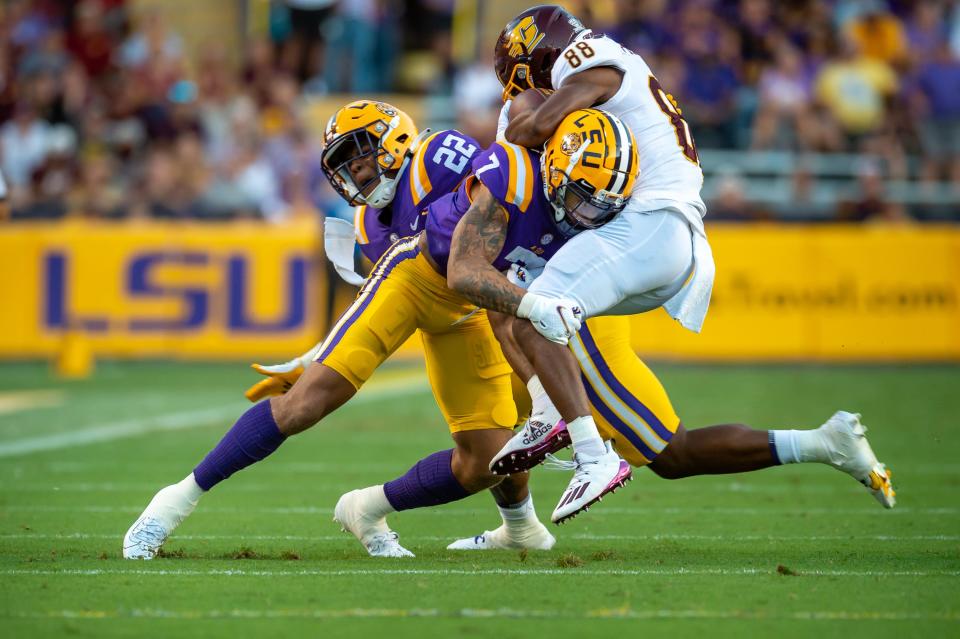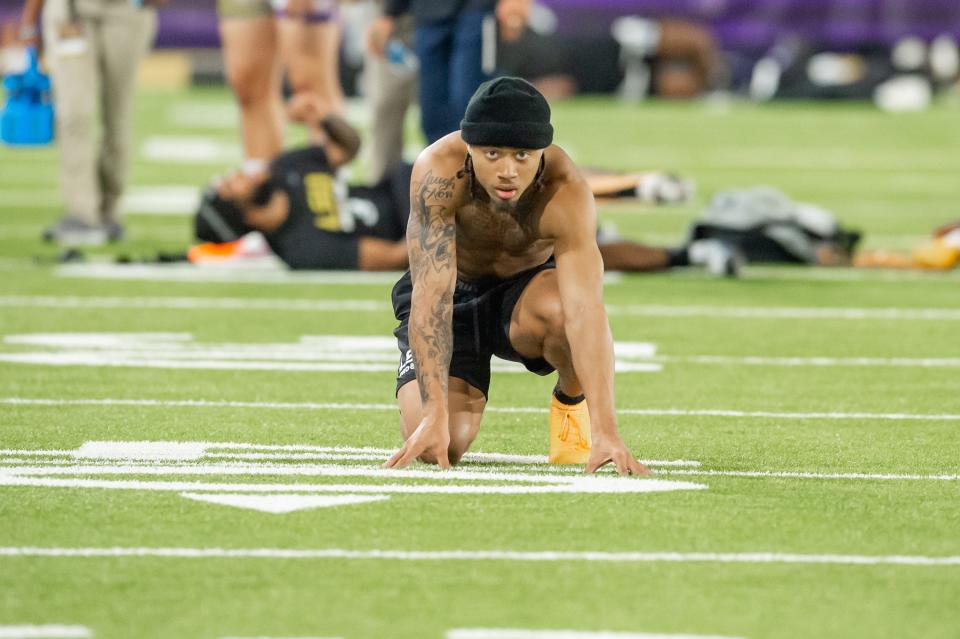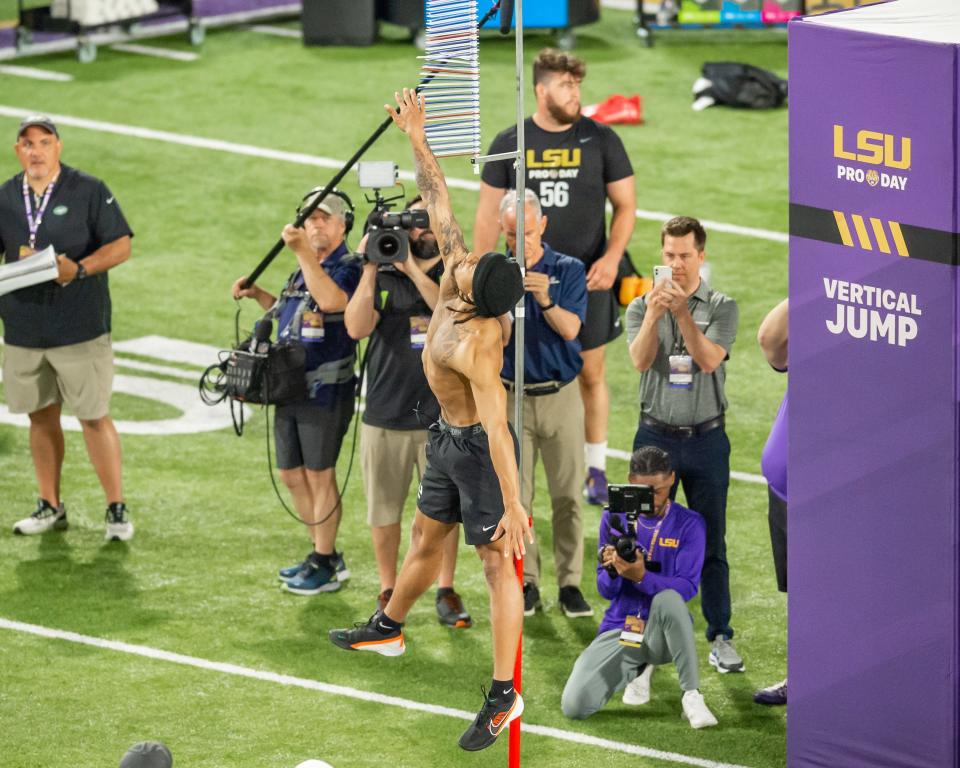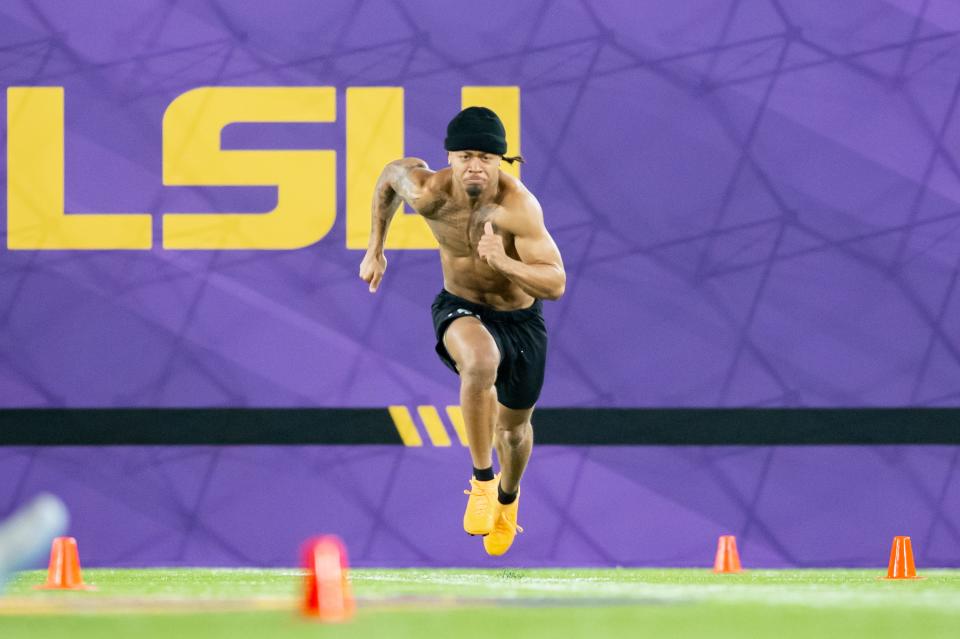Derek Stingley Jr. is ready for NFL, where his grandfather was paralyzed by brutal hit
![LSU defensive back Derek Stingley Jr. leaves the main media room at SEC Media Days in the Hyatt Regency in Hoover, Ala., Monday, July 19, 2021. [Staff Photo/Gary Cosby Jr.]](https://s.yimg.com/ny/api/res/1.2/rm6gbz1pXJtfO3OvxxuMrw--/YXBwaWQ9aGlnaGxhbmRlcjt3PTEyNDI7aD04NTc-/https://media.zenfs.com/en/the-daily-advertiser/9217aebe46e0a6dea3b1e9cf6bd9561d)
- Oops!Something went wrong.Please try again later.
- Oops!Something went wrong.Please try again later.
- Oops!Something went wrong.Please try again later.
- Oops!Something went wrong.Please try again later.
BATON ROUGE — Count Derek Stingley Jr. and his father among the nearly seven million viewers of a viral video posted in May depicting a child absorbing vicious helmet-to-helmet contact in a full-speed, full-pads tackling drill. The eight-second clip of two youth players colliding in practice in the Wesley Chapel Weddington Athletic Association, near Charlotte, N.C., drew stern rebuke from current and former NFL players alike.
Former Dolphins linebacker Channing Crowder called it child abuse.
Former Steelers Pro Bowl linebacker James Harrison cited the play as indicative of why he wouldn’t let his kids play football until after he retired, so that he could monitor how they were being coached.
NFL Vice President of Football Development Roman Oben described the video as “abhorrent.”
But for all the outrage over the video, few if any of its viewers have as much perspective on it as the Stingleys. Derek Jr.’s grandfather, Darryl Stingley, was made a quadriplegic after an infamous hit to the head by Jack Tatum in a 1978 preseason game between Stingley’s New England Patriots and an Oakland Raiders franchise that had forged its image through intimidation. Tatum, a hard-hitting safety who stood at the core of that reputation, benefitted from playing in an NFL era that didn’t regulate tackling much beyond hits delivered too far out of bounds or too late after a whistle.
SHOWING OUT: What former LSU football cornerback Derek Stingley Jr. showed NFL teams at LSU pro day
MONEY MAKER: Waitr signs LSU star Derek Stingley Jr. to NIL deal
It was among the iconic hits in NFL history, but for all the wrong reasons – a sad and permanent benchmark for the future of player safety. An impetus for change that came one tragedy too late. Nobody could’ve blamed the Stingley family if they’d gone on a decades-long campaign against the sport and the risk of head injuries that goes with it.
The Stingleys, however, remain a football family.
Derek Jr. found the youth video disturbing like anyone else. But the younger Stingley, the latest in a long line of highly-regarded defensive backs at LSU and a top-shelf prospect heading into Thursday's NFL Draft, also considered the broader impact on youth interest in the sport.
“That kid won’t ever want to play again,” he told his father. “That kid is thinking, ‘Why am I out here doing this?’”

Stingley Sr., who played and coached extensively in the Arena Football League, never forced the sport on his son. But once the boy was drawn to it, he was going to make damned sure Derek Jr., would be mature beyond his years not only in strategy, but also in safety. The result: an immensely talented cornerback with the ability to lock down the opposing team’s top receiver so tightly, safeties were free to cheat toward other receivers. And along with being one of the draft’s top cornerbacks, he just might be its most conscientious tackler as well.
That serves him well in an era of football that now, for safety reasons, challenges defenders to avoid even incidental contact with a ball carrier’s head. At risk of ejection or suspension for doing so, Stingley Jr. played an entirely different game at LSU than the one his grandfather navigated more than 40 years ago.
“I was nervous about Derek playing at first, because we understand as a family what that can do to a family, the injury part of it,” Stingley Sr. said. “So I was going to teach him to tackle the right way. And the earlier the better.”
His grandfather's tragedy
1979 – The year after Darryl Stingley is paralyzed, the NFL implements a more specific definition of unnecessary roughness, outlawing the use of the helmet to “butt, spear or ram” an opponent, or use the top or crown of the helmet unnecessarily.
Infantile amnesia, the inability of adults to retain early childhood memories, nearly robbed Derek Stingley Jr. of a special one. He clings to a single permanent image of his grandfather, as he was only 5 years old when Darryl died in 2007.
“I was sitting on a pool table, throwing pool balls into the holes on the table, and he was in his wheelchair,” Stingley Jr. said. “And he was giving me a full set of Darth Vader stuff as a gift. I got the mask, the cape, the light saber, this thing that made the breathing noise, all of it.”
Stingley Jr. can only judge the tackle that paralyzed his grandfather from old, grainy video of the Steve Grogan pass that remains an easy search on YouTube. He recognizes it was brutal and violent, but also that it wasn’t technically dirty for the day. Indeed, Tatum didn’t draw a suspension or even a fine. Heck, no flag was thrown because no rule was broken.

When Stingley entered the NFL as a rookie in 1973, goalposts were still anchored at the front of the end zone, not the back. A forceful, open-handed blow to the earhole of the helmet – Deacon Jones’ infamous head slap – was still a legal pass rush move. And for the roaming enforcers at the safety position like Tatum, helmet-to-helmet contact was not only legal, but lauded.
“The game was just brutal. The Raiders, Good Lord, it was like freaking MMA out there with them half the time,” Derek Sr. said.
LOCKDOWN MAN: LSU's Derek Stingley Jr gives injury update, says he's the best cornerback in NFL Draft
GOING PRO: Here are the LSU football players that have declared for the 2022 NFL Draft
Stingley broke two vertebrae on the play – a slant pattern that Grogan overthrew, causing Stingley to extend himself while running into Tatum’s vicinity – and was left with only limited use of his right arm. The injury helped bring about advocacy for medical disability benefits to retired NFL players, pushed by former NFLPA executive director Gene Upshaw, a Raiders All-Pro guard who befriended Stingley and was on the Oakland sideline when he was hurt. Raiders coach John Madden also became close to Stingley and visited him often at his home in Chicago for many years after the injury.

Tatum spoke of regret for what happened to Stingley, but never reached out to him personally. A meeting between the two was arranged for a TV broadcast in 1996, only to be canceled by Stingley when he learned Tatum would use it to promote his book, "They Call Me Assassin," which Stingley believed was written in poor taste.
“My dad never spoke ill about him. But he always said, ‘My phone number’s never changed.’ That’s all he would say about him,” said Derek Sr.
Adjusting to paralysis was no easy task. Publicly, Stingley’s outlook on life remained positive and uplifting. In an interview with broadcast icon Howard Cosell about 13 months after the injury, he couldn’t have come off more gracious. Privately, however, it took time. Derek Sr. recalls his father getting upset and yelling more than he ever had, and having to tip-toe around his moods for a few years. One day, he confronted his father about the outbursts.
“I asked him, ‘Dad, why are you yelling so much?’ He said ‘Derek just imagine you want to get up and walk away from a situation if something bothers you, to take a ride, take a walk, clear your head. I can’t do that anymore. So I’m more frustrated than I’ve ever been in life, that I can’t do that anymore. I don’t mean to be that way toward any of you, it’s just how I’m feeling.’” Derek Sr. said. “I think after that, but much later, he accepted the body he had to live in.”
One thing Darryl Stingley never did, however, was blame the game.
He was happy for his son to play football and ecstatic when he learned that Derek Sr. decided to walk away from a three-year minor-league baseball career as a 26th-round draft pick of the Philadelphia Phillies and strap football pads on once again to embark upon a career in the Arena League. He was equally glad to know Derek Jr., even at the tender age of 5, wanted to pursue a football career of his own.
Stingley lived 26 years on his feet and 29 on wheels. His quadriplegia was listed among contributing factors to his death.
Textbook tackling technique
1985 – Beginning this year, NFL ball carriers can declare themselves down by sliding to the ground feet first.
The form is, in a word, textbook.
Feet square and shoulder-width apart, knees bent, hips sunk, and most important of all, head up. The photo of Derek Stingley Jr. readying himself to make a tackle was taken when he was just 9 as a cornerback for the Southside Patriots in Baton Rouge, La. At that age, proper tackling is heavily emphasized, but rarely well-executed.
Stingley Jr. had it down cold.
Sitting at his kitchen table at the southeastern edge of Baton Rouge, an easy drive from the youth field where the photo was taken, Derek Sr. examines his son’s posture in the photo and nods with approval.
“Head up, ready to shoot and wrap, and keeping outside leverage,” Stingley Sr. says. “All the things he’d been taught.”
According Jay Johnson, Stingley Jr.’s first youth coach, his father had taught him not only how to tackle, but how to fall – he’d hit the ground with a roll. Daniel Sibley, his coach with the Southside Patriots, preferred Stingley to be at the front of the line in tackling drills so other kids could see a fundamentally-sound demonstration before getting their turn.
“At that age, there’s a lot to teach on tackling. They’re still trying to figure out their own bodies. It’s a lot of work,” said Sibley. “When it was Derek’s turn, I’d say, ‘You guys watch this right here.’”
Having grown up with a father who was paralyzed on a football field, Stingley Sr. wouldn’t have his son play the game with anything less than a full understanding of safe contact. He started him in flag football and even placed him in an instructional league in which no score was kept and no games were played – strictly an emphasis on blocking and tackling fundamentals – before putting him on an organized team.
Stingley Sr. made a lengthy career in the indoor arena league – nine as a player and 11 as a coach – and his son was by his side for much of his coaching tenure. As young as 7 years old, he’d attend his father’s AFL practices and would jump into individual drills with the defensive backs. He’d sit in on defensive meetings.
“If you didn’t know your responsibility in a certain defense, against a certain look, Sting would turn around and ask Little Sting the same question. And here was this 8-year-old kid, and he’d know it every time,” said Alvin Ray Jackson, a linebacker who played for Stingley Sr. for five arena seasons. “If you didn’t know something Little Sting knew, the rest of the room would get on you. That’s how it was.”
Facing the 'Robo-Scout'
1990 – NFL players who use the helmet to butt, spear or ram an opponent can face ejection if the action is deemed flagrant or violent.
Playing up, the youth athletics phrase for competing at a higher level, was nothing new to Stingley Jr. He’d played varsity football at The Dunham School in Baton Rouge in the eighth grade. The year after that, as a ninth-grader weighing just 150 pounds, he blanketed older and much bigger receivers at an LSU summer camp well enough to earn a scholarship offer from then-LSU coach Les Miles. As a high school sophomore, he could effectively cover his position coach, Byron Johnson, who’d been a college wide receiver just a year earlier. His speed and skill had always demanded a level up for sharpening.
But this was different.
This was Robo-Scout.
Stingley walked toward the Dunham practice field on a Monday prior to a Friday night playoff game and took notice of “one of the biggest athletes I’d ever seen.” He quickly learned why Christian Briggs was there – to give Stingley a challenge like he’d never faced before. Briggs had been a teammate of Johnson’s at Southeastern Louisiana, and had drawn tryouts with the Seattle Seahawks and Indianapolis Colts. He stood 6-foot-5 and weighed 240 pounds – about 20 more than his playing weight in college, because he’d beefed up to satisfy the Seahawks’ vision that he belonged at tight end.
Johnson had asked Briggs to visit for the week and run routes against Stingley, without pads on for liability reasons, to help prepare him for a size disadvantage he’d be facing in that week’s playoff game.

Dunham players, star-struck by Briggs’ massive physique, nicknamed him “Robo-Scout.” The first day, Briggs got the best of Stingley. On one rep in particular, Briggs said, he knocked him off balance with a jab to the chest for an easy release. Stingley was furious with himself, enough that he spent all night studying video that he’d downloaded of his reps against Briggs.
“I wasn’t going to let this dude demolish me all week. I had to figure something out. Had to,” Stingley said. “I get to my room, get on the Hudl app, and he was just overpowering me. So I’m thinking I shouldn’t try to put as much contact on him so he can’t use all that size against me.”
The Tuesday matchup, Johnson said, was a draw. On Wednesday, Stingley was more than holding his own. Two days later in the playoff game against Riverside Academy, he picked off a pass on one of the very plays Briggs had been asked to simulate. The game was one to forget as Dunham’s season ended with a loss, but the Stingley-Briggs practice matchups were unforgettable for those who witnessed them.
“Later in the week, I faked that same jab on him, and he was balanced and ready for it,” Briggs said. “And I laughed and tapped him on the helmet like ‘OK, you’re onto that now.’”
Challenging Ja'Marr Chase and Justin Jefferson
2010 – All players defined as “defenseless” are protected from blows to the head or neck delivered by an opponent’s helmet, forearm or shoulder.
About a year after grappling with Robo-Scout, Stingley Jr.’s ability to compete with players at a higher level got a much stiffer test. He graduated from Dunham a semester early, in December 2019, and on the very day he signed with LSU, the Tigers coaching staff invited him to participate in Fiesta Bowl practices under an NCAA rule that allows early-enrollers to do so.
Just two days after signing, and barely four weeks after playing his last high school game, Stingley Jr. lined up across eventual first-round picks Ja’Marr Chase and Justin Jefferson, plus 2020 second-rounder Terrace Marshall Jr.
The result: three interceptions during the practice week, after which LSU defensive coordinator Dave Aranda declared the newcomer the most impressive defensive back on the team that week.
“He was right out of high school and guys didn’t even know who he was, and he made a bunch of plays on the ball,” said then-LSU secondary coach Corey Raymond. “Picking them off, knocking balls out, really tight coverage. It was like he’d been with us the whole season.”
Aranda’s assessment was all the more notable by LSU’s reputation as “DBU,” a veritable factory for drafted defensive backs – 26 over the last 20 years. It’s a tradition Stingley Jr. now carries not only as a top prospect but also as a Baton Rouge native who grew up in the shadow of Tiger Stadium. Patrick Peterson, Tyrann Mathieu, Jamal Adams, Tre White – the list he now punctuates seems endless, and Stingley has close personal relationships with both Peterson and Mathieu. Another of those 26 defensive backs, ESPN NFL analyst Ryan Clark, worked with Stingley for two years as a private coach. Clark played 13 seasons in the NFL, mostly with the Steelers.

“I was talking to scouts at the (2020) combine who thought he could’ve been picked over (Jeff) Okudah that year, just off his freshman season,” Clark said. “They hadn’t completely dove into his film yet, but that’s what they saw. He tracks the football better than anyone in the country. He’ll be on a level that starts with Jalen Ramsey and ends with Jalen Ramsey. That type of elite level skill.”
It was a long time in the making.
How you react to life
2011 – A receiver who has completed a catch is deemed “defenseless” until he has had time to protect himself or has clearly become a runner.
Whenever Derek Stingley Jr. walks into his Baton Rouge, La. home, a large textual art hanging blares off a wall to his immediate right. Anytime he leaves, it beckons his attention from the left, like a recurring text message he’s not allowed to miss:
“Life is 10% what happens to you, and 90% how you react to it.”
It speaks to him, this family creed. It cuts through the noise that spins most 20-year-old heads and reaches him in a way any parent would hope for in hanging an inspirational message for a youngster’s benefit.
Why wouldn’t it?
“I’ve been hearing that saying my whole life,” Stingley Jr. said. “The first person I heard say it was my dad, and he preached that to all his players.”
More than just a catchphrase of sound advice, it also carries a profoundly personal significance; a philosophy passed down from father to father in the Stingley family. Darryl Stingley, wheelchair-bound and left to grapple with the reality that his life had forever changed, eventually wrote an autobiography, "Happy to be Alive," which is rife with post-injury reconciliations that helped him reshape bitterness into a more positive outlook.
Derek Sr. used to quietly buy new helmets for his son’s youth teammates if he saw theirs were too loose or didn’t fit correctly. Yet as Dunham’s defensive backs coach, he never once invoked his father’s tragedy in teaching the right way to tackle. He didn’t see the need to stoke fear in kids whom he’d taught to play safely. Darryl Stingley had always told him not to fear injury, despite what had happened to him, because fear can beget injury.

Derek Sr. gave his son the same advice. This despite once being knocked out cold for several minutes from a helmet-to-helmet collision in an AFL game. He still has his father’s last helmet, the one that absorbed Tatum’s fateful blow.
“I had always heard there was a crack in it,” Derek Sr. said. “I’ve searched for it all over, but I haven’t found it.”
Meanwhile, Derek Jr. now plays in an era where tackling rules have evolved defenders, particularly defensive backs, into the anti-Tatum. The head and neck area of a ball carrier is not only rule-protected from blows from a defender’s helmet, but as well from shoulder pads and forearms. At the NCAA level, the targeting foul draws an ejection, along with a first-half suspension in the defender’s next game if the foul occurs in the second half. In the NFL, while ejections are discretionary, a first offense for illegal use of the helmet draws a $20,000 fine, and a $15,000 fine is levied for hitting a player defined as defenseless. On a second offense, the dollars double.
Neither father nor son question why more stringent tackling rules weren’t put in place in 1979, in the immediate wake of Tatum’s vicious hit on the family patriarch.
“It makes it very tough, because they don’t want us to go too high, and when we go low, in the legs, people are going to say that’s a cheap shot,” Derek Jr. said. “Just having one little target to make a tackle on when the receivers or ball-carriers can drop their head on us, it makes it really difficult.
"But that’s the era we live in today and we just have to deal with it.”
Through and through, a football family.
Derek Sr. extends his head to the left and right, in an exaggerated way, to demonstrate how he taught his son to keep his head to the side of a tackle. Derek Jr. was never once flagged for targeting in college
Stingley Sr. reflects on the youth video that rightly drew the ire of so many NFL players, and, like his son, considers not only the kid who absorbed a dangerous head collision, but also the bigger picture.
“You have one kid who will want to get out of the game,” Stingley Sr. said. “He’ll be a basketball player now … and this kid who put that hit on him, he’s moving up and thinking, ‘That must be how you do it.’ It’s got to be nipped in the bud.”
This article originally appeared on Lafayette Daily Advertiser: Derek Stingley Jr's path to NFL Draft shaped by paralyzed grandfather

